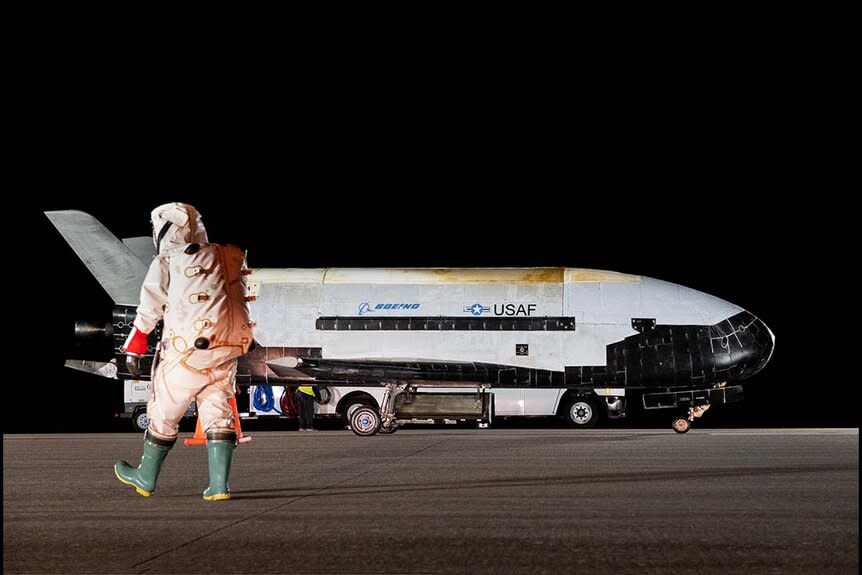What We Know About Space Force's "Secret" Space Plane and Its Upcoming Mission

When we played Battleship as kids, we didn’t know there could be aliens involved, but the makers of the 2012 screen adaptation (streaming now on Peacock) didn’t have the same limitations. When a handful of alien spaceships show up and plunge into the Pacific, a not-so-secret military action is triggered to stop the conquering aliens before they can alert reinforcements back home.
Here in the real world, our military has its own not-so-secret space-based activities, largely carried out using the secretive X-37B space plane. Reusable spacecraft are an increasingly important part of modern space travel, reducing the cost per flight. Recovering and reusing rocket stages is one part of that equation and reusable vehicles are another. To that end, various United States government agencies have operated semi-secret reusable space planes for more than a decade.
The U.S. Government's Secret Secretive X-37B Space Plane
The X-37 program began at NASA in 1999, long before the last flight of the shuttle program, but by 2004 the vehicle and its activities were under the control of DARPA. Two years later, the United States Air Force announced their own iteration, the X-37B, also known as the Orbital Test Vehicle (OTV). Responsibility for the X-37B then shifted again in 2019 and is now under the domain of the United States Space Force.
RELATED: Space Force reveals official uniform design - and they look kinda familiar to Star Trek, BSG fans
Built by Boeing, the X-37B’s design is clearly derivative of the Space Shuttle but at one-quarter scale. The uncrewed vehicle is roughly 29 feet long, 9.5 feet tall, and has a wingspan of approximately 15 feet. Its payload bay is only 7 feet by 4, roughly comparable to the bed of a pickup truck. It’s so small, in fact, that under the original plan it would have been launched inside the payload bay of the Shuttle and deployed like a metal space baby.

Space Force's X-37B Space Plane returns to Earth. Photo: United States Space Force
What few details Boeing has released reveal that the craft has systems to automate deorbit and landing maneuvers, is made of a light composite material instead of the conventional aluminum, and sports updated heat shielding and insulation. First launched in 2010, it’s no secret that the X-37B exists and we even know some of what it’s doing up there, but many of its specs, payloads, and activities are classified, necessarily hidden from view. To date, the vehicle – there are actually two planes which fly different missions – has flown a total of six missions and is preparing for a seventh.
Space Force's X-37B Space Plane Prepares for Seventh Mission
The X-37B’s upcoming seventh mission is planned for launch on December 7. It will lift off from Cape Canaveral atop a Falcon Heavy rocket, considerably more powerful than previous launch vehicles. Prior missions have flown atop SpaceX’s smaller Falcon 9 or Atlas V rockets, the same rocket used to launch the Mars Reconnaissance Orbiter (MRO) and the New Horizons mission that revealed the face of Pluto.
A few sparse details of the upcoming mission were revealed in a statement from Space Force. Part of the mission involves operating in “new orbital regimes” which explains the need for a Falcon Heavy to boost the plane into a higher than usual orbit. The craft will also be carrying experiments dealing with space domain awareness technologies and the effects of radiation.
RELATED: Grab your jetpacks! U.S. Space Command set to launch next week, per Vice President Pence
“The X37B continues to equip the United States with the knowledge to enhance current and future space operations. X-37B Mission 7 demonstrates the USSF’s commitment to innovation and defining the art-of-the-possible in the space domain,” said Gen. B. Chance Saltzman, Chief of Space Operations.
Most of the payloads and experiments aboard the X-37B are a complete mystery, but we do know one of the experimental passengers heading into orbit. Mission 7 will carry NASA’s Seeds-2 experiment which will expose seeds to space radiation during a long duration flight. Understanding how plants are impacted by the environment of space could impact the future of long-term crewed space missions. Whatever else they’re up to, Space Force isn’t saying, but it’s probably not anti-alien weaponry.
The fight for Earth’s future is happening now in Battleship, streaming on Peacock.

